Kit Laybourne muses about the evolution of independent animation and looks "below the radar" for the growth of new emerging domains of digital animation.
It is Marshall McLuhan's fault that I'm a sucker for new technology.
As I try to reconstruct the damage, there are two particular "think bombs" that McLu exploded in my mind back in the early 1970s when I happened to sit in on one of his classes at the University of Toronto's Center for Culture & Technology.
The first is one of his classics. Professor McLuhan observed that the content of a new medium was the form of the medium it replaced. Thus it is that TV is filled with film just as today's Internet (we can deduce) is filled with TV. This precept has provided me a lasting fascination with new media forms: home video, cable TV, computer software, multimedia, the Internet andmost recentlythe yet unborn promise of interactive television.
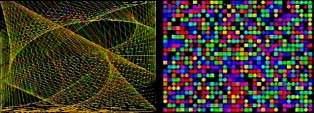
These still frames from a shareware package called "Darkside" for the MacIntosh exhibit the non-narrative, often mathematical designs of early screen savers.
Professor McLuhan's unleashed fury imprinted me even more deeply. I remember holding my breath while the guru screamed at a very smart graduate student who, moments earlier, had blown me away with a barrage of insights on some topic or other. "Stop wasting our time!" shouted the professor. "We're not looking for answers here. We want good questions!"
In this article I'll try to squeeze out some good questions about the emerging domains of digital animation. I'll do this by calling attention toward a world I am constantly stumbling overand delight in. It is the world of self-engendered, spontaneous, vernacular art. It is not the world of cyber-art or of galleries, grants and artistic pretensions.
My method is to present some screen grabs that will remind you of similar stuff that you have undoubtedly come across. Together, let's scan five backwaters of Animation. I think of these as "Below-the-Radar."
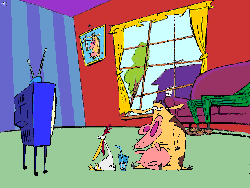
One step beyond flying toasters: This frame grab from a recent Cartoon Network screen saver illustrates how much this mini-medium has evolved to portray narrative material. © Cartoon Network.
Screen Savers
The first screen savers had their origins in something purely digital. They were created not by trained artists, but by computer programmers. Early screen savers tended not to be narrative at all, rather they were kaleidoscopic and geometric. They were based in math and in random algorithms. They seem, to me at least, closer to 20th Century music than 20th Century art, literature or film. They are sculptural. They are electric. They are kinetic. They are visual tone poems. They are more from the East than the West -- from the inner world of meditation and mandalas.
The second screen savers examples are pretty representative of the commercialization of this odd backwater within computer art. They are licensed properties that are not so much little stories as little echoes, playing off the characters jammed into our head by comics and television and the movies.
Doesn't this evolutionary progression from something new and fresh to something very familiar seem to be going in the wrong direction? Can we do something that will liberate screen savers from the fate of being consigned to a world of pre-packaged, pre-digested iterations of the popular culture? For instance, can we create a web site that would curate, with spirit and irreverence, a renaissance of screen savers?
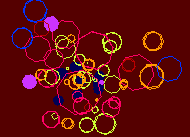
Scott Snibbe's GIF animation, Bubbles. © Scott Snibbe.
Web Animation
The Internet is peppered with animations ranging from simple GIFs to Quicktimes to Shockwave to Java. These little animation shards function as sign-posts. They call out for attention; to urge the surfer to pause for a moment and click on the cycling image. They make you want to find out what's underneath; to find out, literally, what the motion is all about.
Could these artifacts be the first primitive signs of a new visual code system? I think of them as peripatetic, jitterbug logos. They screech out in a way that is immediately accessible to any 21st Century viewer. Can those of us who find ourselves designing such billboards push them further toward an international short-hand that doesn't require literacy in English? Digital Gaming The guys in the movie and television business don't really know that video games are a multi-billion, global industry that is bigger than movies. They don't get it that the incredible draw of computer games is far, far deeper than some form of adolescent aggression or "the twitch response." The basic pull here is that of interaction. At heart we are a curious species and most of us don't want to be told how to do anything. We like to find our own pathways. We strive to be individuals -- to mark our passage with the declaration that we are unique. Digital gaming points to this root impulse and asks.... How can we make the digital media more responsive to its end users? How can we harness the impulse to explore, to earn our victories and to feel our mastery evolve through direct experience? Can we use video games as a template that might bring and hold young audiences to matters of substance in the arts and humanities?
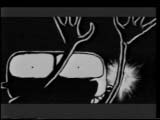
Shadow Puppets, Chuck Gammage's short animated film created entirely on a desktop computer is representative of a whole new era of independent animation.
Desktop Animation
With the designation "desktop," I mean animation that has been created by independent artists for the purpose of personal expression. Although the art world has long recognized parallel examples of "expanded cinema" and "experimental video," the general public sees very little of it. In that sense it is "Below-the-Radar."
As the readership of Animation World Magazine well knows, today the tools and techniques of desktop animation are accessible to everyone. With off-the-shelf software driving inexpensive scanners and digitizing cameras, production is an integrated process whereby one file evolves from storyboard to animatic to leica reel to finished piece, complete with digital tracks. The tools are there, but you have to look hard to find places where the alternative, experimental, private voices of animation can be found on public and commercial airwaves. How can we support showcases for the cream of desktop animation? How do we build audiences for alternate fare? Is there a way to get money to the makers? The non-theatrical market for films and videotapes has died. Can we replace it with something? You know the conundrum as well as I: can there be free and open expression within communications media that are controlled by commercial interests?
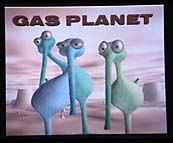
Gas Planet by Pacific Data Images (PDI) artist Eric Darnell is an example of the fusion of high technology and independent art which is occurring as artists are given access to studio technology to make independent films. Image courtsey of PDI.
There are a lot of other hotbeds for Below the Radar Animation. For instance, some really powerful work is coming out of places like the Digital Club House in San Francisco, where teams of teacher/artists work with community citizens to fuse animation and live-action to produce their own multi-media biographies. In classrooms at both college and high-school level, innovative animation is cranking. I've seen it. Even at the high end production houses, places where you might expect each nanosecond to be monopolized by big-buck clients, you can find talented animators, writers, directors and techies joining together in an exuberant and almost clandestine exploration of what animation can be. In the Spirit of McLu... What is the unique voice of these new digital tools? We know that computers are wonderfully adept in supporting the traditional aesthetic and production tasks that reside in making any piece of animation. Computers help in storyboarding, making animatics, doing pencil tests, in-betweening and digital ink & paint. But aren't computers their own art form? We can see that the medium has begun a new and vibrant expansion. Where will this go and how do we celebrate breakthroughs?
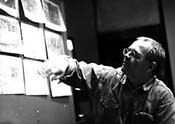
Kit Laybourne.
Visit http://www.awn.com/animation/ to view a gallery of simple GIF animations created by various artists.
Kit Laybourne is behind one of the sweetest shows on TV ( Gullah Gullah Island) for Nickelodeon and the most twisted ( Liquid Television) for MTV. He is currently executive producer of Hank The Cowdog, an animated feature film and television series being developed by Nickelodeon. During the 1995-96 academic year, he taught the Advanced Animation Seminar at NYU's Tisch School of the Arts. He also authored one of the standard texts on animation, The Animation Book, with a new edition covering digital animation to be published by Crown in September 1998.







